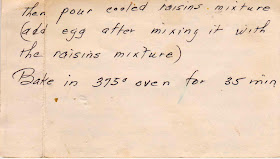Last Saturday, I hosted a dinner party attended by some very knowledgeable food world folks but fortunately one of them,
Arthur Schwartz (along with his charming partner Bob Harned) brought the main course -- delicious barbecue from
Fletcher's in Brooklyn. Responsible only for dessert, I decided to make
Three-Ingredient Lemon Chiffon Pie (thinking it would be a refreshing counterpoint to the rich entree) and some cookies (pictured above) from a "new" old recipe in my collection.
The recipe intrigued me for three reasons: it was untitled (as in what kind of cookies are these?), its unusual method of preparation, and because of a note at the bottom of the scrap of paper on which it was written:
Cookies from Mrs. Martin she had gotten it from Edith's mother. (More on these wonderful cookies later in the post.)
The dinner got off to a most inauspicious start or, as Arthur said, it was "fakakta." First, the DH was called into work last-minute. Arthur and Bob, upon arrival at my place, discovered that the barbecue order was missing some essential dishes, and had to return to Fletcher's. Aylin OneyTan, the renowned Turkish food writer visiting New York for a cookbook conference, was running late. But not as late as two other guests, Joe Mizrahi, of
Smokin' Joe's True Blue Texas Barbecue and his girlfriend Lilly Braun Goldbard whose family emergency found them an hour away in Jamaica, Queens, when they should have been in Brooklyn.
But it all turned out fine. The DH arrived home in time for the end of the main course. Arthur and Bob got the missing ribs -- and a parking spot. Aylin arrived bearing wonderful Turkish treats (more on that below), and Joe and Lilly made it here in record time, though Joe, in his rush, did not bring the artisenal hot dogs and kielbasa he made and wanted us to try. Hopefully, there will be a next time.
 |
| From left: Joe, Lilly, the DH (Paul), Arthur, Aylin and Bob. |
Now, on to dessert. These cookies, which are really gingersnaps, are delicious, even better the day after they're baked. You can make then thin and "snappy" or make them a bit thicker and softer. They're excellent in both incarnations.
In most cookie recipes, one creams the butter and sugar. This recipe calls for boiling sugar and molasses, and then melting the butter in the hot mixture. Aylin, an expert in Turkish cuisine, said she was familiar with this technique, but I've rarely seen it in American recipes.
When the mixture is cool, the eggs are added.
The dry ingredients, among them flour, cinnamon and ginger.
The recipe says to "add flour enough to roll." I used about five cups. This makes a lot of cookies. You can cut them with any cookie cutter, but I'd recommend one not exceeding 1.5 to 2 inches. The dough is sticky and smaller cookies are easier to transport the baking tray.
If you want a soft, chewier cookie, roll the dough a bit thicker and reduce the baking time. Do the opposite if you want a crispy cookie.
These cookies played second fiddle to the pie (as cookies often do) but if I'd not had so much wine, I would have remembered to serve what would have been the evening's highlight dessert -- Pismaniye. This Turkish sweet, brought by Aylin, looks like string (below). It's made by blending flour roasted in butter into pulled sugar and is sort of like cotton candy, so it's fun to eat, but has a more interesting texture and more complex flavor.
I should have figured Aylin would have brought something interesting. She led a Context tour that the DH and I took in Istanbul, introducing us to all sorts of
mind-blowing foods. And even though she lives in Turkey, I can still follow her (and so can you!) as she writes the
Fork and Cork column in the English-language Hurriyet Daily News.
Finally, the cookie recipe!
Gingersnaps
1 C sugar
1 C molasses
1 C butter (two sticks)
2 eggs, beaten
1 tsp. baking soda dissolved in 1 tbs. hot water
1 tsp. ginger
1 tsp. cinnamon
1/2 tsp. salt
5 (or more) cups of flour
Preheat oven to 350 degrees
Bring sugar and molasses to a boil. Turn off heat and add butter. When mixture is cool, add beaten eggs. Mix thoroughly and add baking soda, ginger, cinnamon, salt and flour. Add flour one cup at a time.
You can refrigerate dough to make it a bit easier to roll out, or simply roll out immediately. Place cookies on parchment lined baking sheet.
Bake cookies for about 8 minutes.
Note: You can control the texture of the cookies by rolling them thinner or thicker and baking them longer for a crispier texture, less for a chewier cookie.
I sprinkled the cookies with a pearl sugar for visual interest, but this step isn't necessary.






.jpg)
.jpg)









.JPG)
.jpg)
0.jpg)






.jpg)
.jpg)






.jpg)




.jpg)




.JPG)
.JPG)


.JPG)

.JPG)
.jpg)
.jpg)